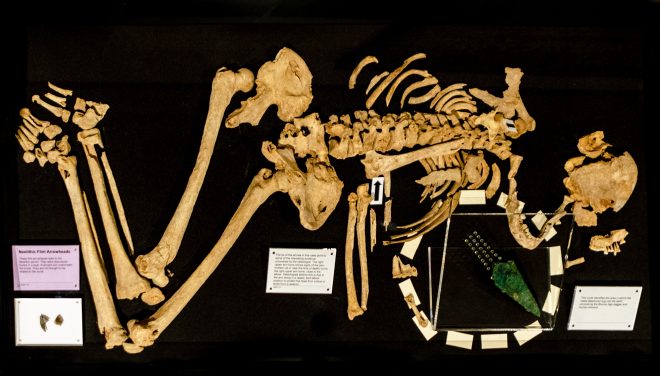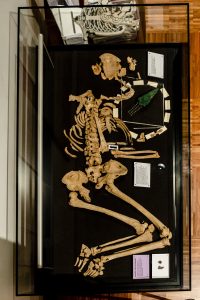Unravelling the story of the Racton Man of the South Downs
July 7, 2025
 People have lived in the South Downs for at least 5,000 years and so much of its archaeology is still being discovered and studied. Anooshka Rawden looks at the fascinating and heart-wrenching story of the Racton Man.
People have lived in the South Downs for at least 5,000 years and so much of its archaeology is still being discovered and studied. Anooshka Rawden looks at the fascinating and heart-wrenching story of the Racton Man.
Imagine dying, in a fight to retain your leadership. You are perhaps in your late 40s or 50s, perhaps older, and as you’ve got older, there is competition for your position. You’ve fought before, your body bearing well-healed fractures from the past. And you’ve won. But younger men seek to take your place…
Your elbow is sliced by a sharp blade, detaching bone. Your nerves severed. A stab wound to the armpit. Blood vessels seeping.
Your grave is in the downland, where you once walked the chalk scarps and the coastal plains. Buried with care (possibly under a mound, long since plough lost) as a sign of your bravery and status and consistent with the respect you held in life. With you is a dagger with an elaborately riveted handle.
So lies Racton Man. Waiting.
Fast forward to 1989, when a metal detectorist discovered a dagger blade and a number of rivets at a site near Westbourne in West Sussex. The discovery resulted in an excavation of the site, which in turn revealed a crouched burial, lying on its left side. The remains are boxed and carefully stored.
Archaeological discoveries – each and every one – has a story to tell, but those stories sometimes wait until science and technology can turn a key in the lock of discovery. Racton Man waited almost 30 years until Bronze Age specialist, Dr Stuart Needham, visited the Collections Discovery Centre at Fishbourne Roman Palace, to visit collections cared for by The Novium Museum. Here was Racton Man, boxed, contained, but ready to tell his story.

Thanks to Dr. Needham, James Kenny (Archaeology Officer for Chichester District Council), The Novium Museum, and specialists from the Scottish Universities Environmental Research Centre and Durham University, the story of Racton Man unfolded. Radiocarbon dating suggested he died sometime between 2300BC – 2150BC. In life, his diet had been rich in meats, and physically he was tall and imposing, possibly over 6ft tall in life and of a robust and athletic build.
His body wasn’t without the markers of illness and aging, with signs of frequent sinus infections, tooth decay and wear, dental abscess and spinal degeneration. And it also showed signs of previous injury, with well healed fractured ribs.
Buried clearly with care – his head may have rested on a pillow made of organic material with his body had likely been buried in a wooden coffin – his dagger was the only object to accompany him. And the dagger tells its own story.
The blade, along with 26 rivets would have formed an elaborate weapon, the hilt rivet-studded and thanks to the work of Dr Needham and a team of specialists, is now understood to be among the earliest bronze daggers to have been found in Europe, standing as it does at the transition between copper and bronze technologies.
The fact it was the only object found buried in the grace also speaks volumes – this dagger symbolised something significant. Other weapons were not needed to accompany this man as this single object spoke of power, prestige and prominence.
 And how did Racton Man die? The wounds discovered on his preserved bones speak of violence.
And how did Racton Man die? The wounds discovered on his preserved bones speak of violence.
With no signs of healing, the injury to the elbow suggests his arm raised and bent, probably to protect his head, while the secondary injury via the armpit suggests strikes made in quick succession.
Why Racton Man’s life ended in violence, we cannot be sure, but a leadership contest through combat is a possibility, especially when we consider the potential of a dagger in such one-to-one combat over its usefulness in warfare.
The dagger points to a man who stood on many edges – life and death to preserve his status, and the transition into the Bronze Age. We do not know if the dagger played a role in Racton Man’s death, but it was most certainly a symbol of his life.
Find out more about the archaeology of the South Downs by visiting the Collections Discovery Centre at Fishbourne Roman Palace and The Novium Museum in Chichester.
Images courtesy of The Novium Museum and Fiona Mills
